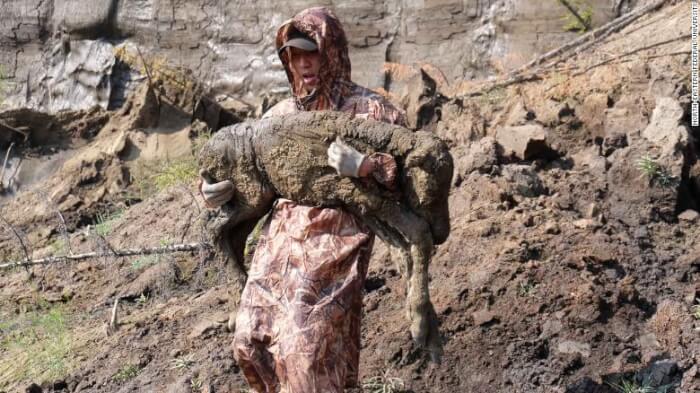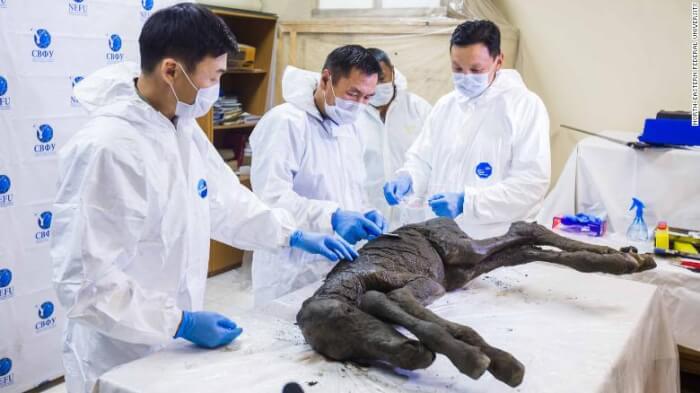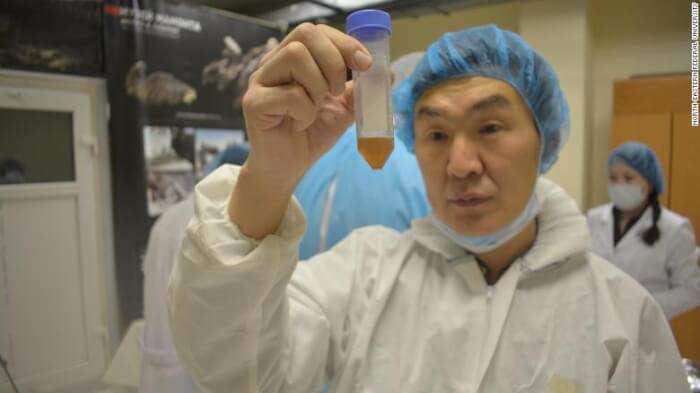Liquid Blood And Urine Discovered Inside Ancient 42,000-Year-Old Foal
Scientists from Russia have discovered liquid blood and urine inside the frozen carcass of a foal lived 42,000 years ago in Siberia's Verkhoyansk region.
The researchers extracted the body fluids from the animal during an autopsy and examined in the expectation of cloning the extinct species, claimed Semyon Grigoriev, director of the Mammoth Museum at Northeastern Federal University (NEFU) in Yakutsk.
“An autopsy showed the foal carcass was extremely well-preserved, the body even without deformation,” he added. “The hair cover also preserved most parts of the carcass, especially at the head and legs.
But there is one thing more unusual: the find of liquid blood and urine. Grigoriev said he was aware of only one other case where experts discovered liquid blood inside an animal from the Pleistocene epoch, lasting from about 2.6 million years ago to nearly 11,700 years ago.
“As a rule, the blood coagulates or even turns to powder in the ancient remains of animals of the ice age, even if the carcass is preserved seems to be well,” Grigoriev explained.
Grigoriev said NEFU specialists were working with experts from the controversial South Korean Sooam Biotech Research Foundation in an attempt to cultivate the foal's cells for cloning, though he was not quite positive about their chances.
"I think that even the unique preservation [of] blood is absolutely hopeless for cloning purposes since the main blood cells -- the red blood cells or erythrocytes -- do not have nuclei with DNA," Grigoriev said. "We [are] trying to find intact cells in muscle tissue and internal organs that are also very well-preserved."
The researchers extracted the body fluids from the animal during an autopsy and examined in the expectation of cloning the extinct species, claimed Semyon Grigoriev, director of the Mammoth Museum at Northeastern Federal University (NEFU) in Yakutsk.
 Source: CNN
Source: CNN
“An autopsy showed the foal carcass was extremely well-preserved, the body even without deformation,” he added. “The hair cover also preserved most parts of the carcass, especially at the head and legs.
 Source: CNN
Source: CNN
But there is one thing more unusual: the find of liquid blood and urine. Grigoriev said he was aware of only one other case where experts discovered liquid blood inside an animal from the Pleistocene epoch, lasting from about 2.6 million years ago to nearly 11,700 years ago.
 Source: CNN
Source: CNN
“As a rule, the blood coagulates or even turns to powder in the ancient remains of animals of the ice age, even if the carcass is preserved seems to be well,” Grigoriev explained.
 Source: CNN
Source: CNN
Grigoriev said NEFU specialists were working with experts from the controversial South Korean Sooam Biotech Research Foundation in an attempt to cultivate the foal's cells for cloning, though he was not quite positive about their chances.
 Source: CNN
Source: CNN
"I think that even the unique preservation [of] blood is absolutely hopeless for cloning purposes since the main blood cells -- the red blood cells or erythrocytes -- do not have nuclei with DNA," Grigoriev said. "We [are] trying to find intact cells in muscle tissue and internal organs that are also very well-preserved."
Share this article
Advertisement